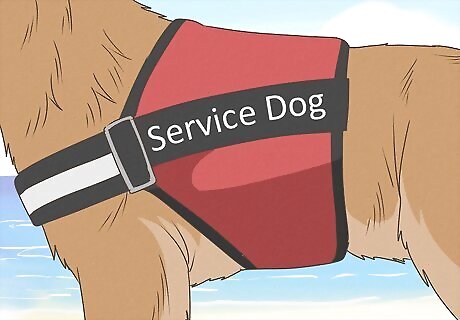
views
- Service dogs are well-behaved, focused, and quiet. Fake service dogs may be reactive, loud, or playful.
- Fake service dogs will be more likely to sniff around, require redirection, or be interested in strangers and other stimuli.
- Don’t pay too much attention to vests or signs; service dogs aren’t actually required to wear special gear and there are no “certificates” for real service dogs.
They’re reactive.

Trained service dogs are too disciplined and focused to act out. Reactive dogs over-respond to stimuli. This causes them to act out around other dogs, strangers, or loud noises. A trained service dog will be incredibly well-behaved regardless of what’s going on around them. Fake service dogs won’t be nearly as disciplined. Service dogs may straight up ignore other dogs or loud noises. They have a job to do, and they tend to lock in pretty hard on that task.
They are being carried.

A service dog will almost always walk on their own. If a service dog isn’t freely walking alongside their owner, they won’t be able to jump up on their owner to warn them, or bark, or yell for help. If someone is pushing their dog along in a stroller or carrying them in their purse, it’s extremely unlikely they’re trained to be a service dog. A real service dog would probably be very resistant if someone tried to put them in a purse or stroller, since that restricts their ability to do their job.
They’re not heeling on leash.

A real service dog won’t pull on the leash or bite at it. Heeling is when a dog walks alongside their owner and moves when they move, and sits down whenever their owner stops moving. You’ll never see a legit service dog tugging on the leash, biting it, or refusing to move whenever the owner tugs on it. You won’t see real service dogs off leash. Most service dogs are trained to be “on the clock” when they’re leashed.
They’re barking or whining.

Legit service dogs know how to stay quiet and out of the way. A service dog is intended to be with their owner through the most unsettling and chaotic situations out there. Crowded grocery stores, concerts, ball games, wherever—a service dog can keep their cool. If you see a service dog losing their composure and barking, whining, sniveling, or groveling, they aren’t actually a service dog.
They’re sniffing everything they encounter.

Excessive sniffing is normal for dogs, but not a well-trained service pup. Dogs follow their noses, and a strong scent can radically drive a dog to investigate it. For normal pups, this is no big deal! For a real service dog though, it’s a sign they aren’t paying attention to the task at hand. Service dogs should monitor their owner and keep their wits about them. The occasional sniff every here and there is no big deal at all, but if the dog is persistently distracted and interested elsewhere, it’s not a good sign.
They’re interested in strangers.

A service dog should basically ignore other people. There’s a reason people often tell strangers not to pet their service dog. They aren’t supposed to focus on anybody other than their owner. As such, a legitimate service dog won’t even make eye contact with other folks. If you see the pup looking around at people and getting excited by the prospect of a new friend, they probably aren’t legit. It’s actually illegal in some states to pet a service dog because it might distract them from the task at hand. It’s even a felony in Arizona!
They’re active and playful.

If you monitor a service dog, they should be dull to watch. Service dogs aren’t really fun. They don’t really frolic, play, or goof off like a normal dog (at least not in public). If the service dog you suspect of being a fraud isn’t a total bore to be around, you might be on to something. Service dogs are trained to be “on” when they’re out and about. They’re normal, playful pups at home, but on a leash in public they should be zoned in on the task at hand.
They don’t respond to redirection.

If their owner gives them a command, a service dog will listen. You won’t see a genuine service dog and their owner going back and forth trying to reach an understanding. When the owner tells their pup to stop doing something, sit, or lie down, the dog should respectfully listen. If you see a lot of bickering going on whenever the owner issues a command, it’s probably not a service dog. Real service dogs are basically as well-trained as a dog can be. If you’re impressed by the dog’s diligence and responsiveness, they’re probably legit.
They’re an uncommon service dog breed.

There are a handful of breeds that are rarely used as service dogs. Any breed of dog can be trained to be a service dog, so this isn’t a 100% accurate test. However, it can help add a data point in your determination! The most common service dog breeds are Labradors, retrievers, German shepherds, poodles, and Bernese mountain dogs because they’re intelligent, calm, and easy to train. You will rarely see: Dogs lower on the intelligence scale, such as bulldogs, chow chows, borzois, and Pekinese. Dogs that are independent and prone to do their own thing, like huskies, Airedale terriers, and akitas. Dogs that insurance companies rarely cover, such as pitbulls, mastiffs, or rottweilers.
They may not have a vest and label.

Owners will typically advertise that the dog is on the job. People tend to put a lot of emphasis on vests, signs, and certificates, but a service dog isn’t actually required to wear any kind of vest or have a sign. With that said, many owners will put a sign like, “Service dog, do not disturb” or “Seizure service dog. Call 911 if barking,” just so people know what to do when they encounter the dog. You should probably put the least amount of emphasis on this component when trying to spot a fake service dog. Some owners don’t put signs or vests on service dogs because they don’t want to broadcast their disability to the world. Somewhere along the line, the general public got it in their head that service animals have to have special certification or some specific kind of vest. None of that is true.















Comments
0 comment